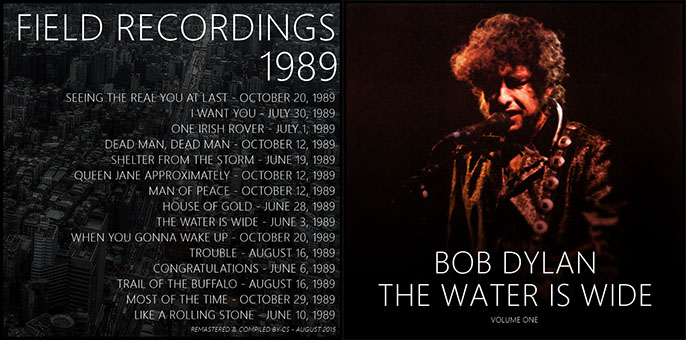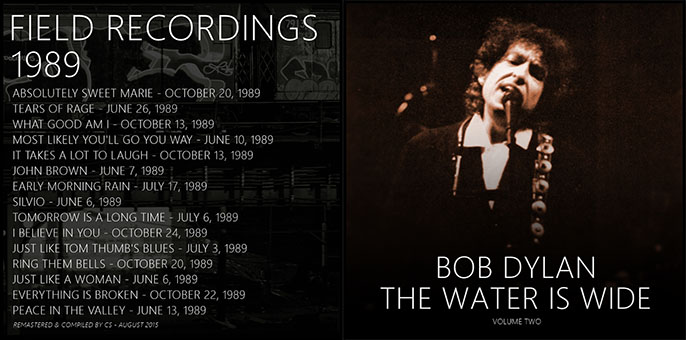BOB DYLAN - The Water Is Wide Vol.1-2
Posted: Sat Nov 21, 2015 6:19 am
Field Recordings 1989
A CS production, August 2015

CD 1 - Volume One:
1. Seeing The Real You At Last - Poughkeepsie, October 20, 1989
2. I Want You - Ottawa, July 30, 1989
3. One Irish Rover - Peoria, July 1, 1989
4. Dead Man, Dead Man - New York City, October 12, 1989
5. Shelter From The Storm - Milano, June 19, 1989
6. Queen Jane Approximately - New York City, October 12, 1989
7. Man Of Peace - New York City, October 12, 1989
8. House Of Gold - Athens, June 28, 1989
9. The Water Is Wide - Dublin, June 3, 1989
10. When You Gonna Wake Up - Poughkeepsie, October 20, 1989
11. Trouble - Atlanta, August 16, 1989
12. Congratulations - Glasgow, June 6, 1989
13. Trail Of The Buffalo - Atlanta, August 16, 1989
14. Most Of The Time - Ithaca, October 29, 1989
15. Like A Rolling Stone - The Hague, June 10, 1989

CD 2 - Volume Two:
1. Absolutely Sweet Marie - Poughkeepsie, October 20, 1989
2. Tears Of Rage - Patras, June 26, 1989
3. What Good Am I - New York City, October 13, 1989
4. Most Likely You Go Your Way (And I Go Mine) - The Hague, June 10, 1989
5. It Takes A Lot To Laugh (It Takes A Train To Cry) - New York City, October 13, 1989
6. John Brown - Birmingham, June 7, 1989
7. Early Morning Rain - Stanhope, July 17, 1989
8. Silvio - Glasgow, June 6, 1989
9. Tomorrow Is A Long Time - Rochester, July 6, 1989
10. I Believe In You - Boston, October 24, 1989
11. Just Like Tom Thumb's Blues - Milwaukee, July 3, 1989
12. Ring Them Bells - Poughkeepsie, October 20, 1989
13. Just Like A Woman - Glasgow, June 6, 1989
14. Everything Is Broken - South Kingston, October 22, 1989
15. Peace In The Valley - Frejus, June 13, 1989
1989 is a very weird, intense year for Bob Dylan concerts when juxtaposed with its immediate predecessor, 1988. Not only was the scope of the tour broadened to include many more countries (1988 only hit the United States) the musical palette was expanded considerably. This was coupled with a significant increase in the gruffness of Dylan's vocals to create a tour that looked a lot like the one before but with very little musical similarity. While 1988 represented a performer playing his music with the most energy he could muster, 1989 presents a much more edgy, experimental side of the singer and band.
One of the primary sounds in the palette, and my favorite aspect of the year, was an emphasis on darker, minor key songs. This was more evident in the Fall Tour, as songs from Oh Mercy made their tour debut, but was present too in the summer. "What Good Am I?", "Most Of The Time," "Tears Of Rage," and "One Irish Rover" represent the more melancholy presentation of this sound. There is a bitterness that is particularly wellserved by the growly delivery associated with these ballads.
The more uptempo manifestation of this sound is perhaps even more interesting. "John Brown," "Trail Of The Buffalo," "When You Gonna Wake Up," and "Dead Man, Dead Man" are all interestingly offkilter performances. The words are not all there, but the vibe is expertly achieved. Check out that strange klezmeresque instrumental in "Trail Of The Buffalo" or the pulsing bass of "John Brown." Even the feedback near the end of "Dead Man, Dead Man" serves to produce this environment of dark heat.
Dylan's 1960s material is given rather impressionistic treatment here as well. "Tears Of Rage" was spectacularly debuted in Greece, and "Just Like Tom Thumb's Blues" is as inventively arranged as Paul Williams suggest in his Performing Artist series. The author Clinton Heylin singles out this performance of "Queen Jane Approximately," played at the Beacon Theater in New York, as especially praiseworthy, and it's impossible to disagree. Evident on that song, as well as a handful of others (including a blisteringly paced "I Want You"), is the second interesting trend of the year bizarre, rambling song endings. This sounds like a negative, and indeed sometimes it was, by the effect could be entirely mesmerizing. The end of "Queen Jane Approximately," for example, plays out like a completely different beautiful song.
The third trend in Dylan's sound on these tours was an increased reliance on inventive cover performances. This presents a continuity with the 1986 tour, but represents a striking break with 1987 and 1988. While the acoustic set had included covers in 1988, the electric set consisted primarily of Dylan originals. As suggested by the circulating rehearsals for 1989's touring, though, there was a distinct emphasis on performing a wide, wide ranger of covers in this year.
On The Water Is Wide,you will find "Peace In The Valley," "House Of Gold," "Early Morning Rain," and an electrified rendition of "The Water Is Wide." Of these, one is a gospel song popularized by Elvis Presley, one is a moralizing Hank Williams country tune, one is a mournful lament by Dylan's contemporary, Gordon Lightfoot, and one is a traditional English song of seventeenth century origin. He had "Early Morning Rain" and "The Water Is Wide" before, on Self Portrait and the Rolling Thunder Revue respectively, but never performed them so effectively. "The Water Is Wide," in particular, remains one of Bob Dylan's most powerful live performances, at least to this listener.
Other intriguing bits include an uptempo country arrangement of "Tomorrow Is A Long Time," apocalyptic electric blues as represented by "Man Of Peace" and "Everything Is Broken," one of the only two airings of the Traveling Wilburys' "Congratulations," and one of the most rollicking performances of "Like A Rolling Stone" this side of 1981.
A CS production, August 2015

CD 1 - Volume One:
1. Seeing The Real You At Last - Poughkeepsie, October 20, 1989
2. I Want You - Ottawa, July 30, 1989
3. One Irish Rover - Peoria, July 1, 1989
4. Dead Man, Dead Man - New York City, October 12, 1989
5. Shelter From The Storm - Milano, June 19, 1989
6. Queen Jane Approximately - New York City, October 12, 1989
7. Man Of Peace - New York City, October 12, 1989
8. House Of Gold - Athens, June 28, 1989
9. The Water Is Wide - Dublin, June 3, 1989
10. When You Gonna Wake Up - Poughkeepsie, October 20, 1989
11. Trouble - Atlanta, August 16, 1989
12. Congratulations - Glasgow, June 6, 1989
13. Trail Of The Buffalo - Atlanta, August 16, 1989
14. Most Of The Time - Ithaca, October 29, 1989
15. Like A Rolling Stone - The Hague, June 10, 1989

CD 2 - Volume Two:
1. Absolutely Sweet Marie - Poughkeepsie, October 20, 1989
2. Tears Of Rage - Patras, June 26, 1989
3. What Good Am I - New York City, October 13, 1989
4. Most Likely You Go Your Way (And I Go Mine) - The Hague, June 10, 1989
5. It Takes A Lot To Laugh (It Takes A Train To Cry) - New York City, October 13, 1989
6. John Brown - Birmingham, June 7, 1989
7. Early Morning Rain - Stanhope, July 17, 1989
8. Silvio - Glasgow, June 6, 1989
9. Tomorrow Is A Long Time - Rochester, July 6, 1989
10. I Believe In You - Boston, October 24, 1989
11. Just Like Tom Thumb's Blues - Milwaukee, July 3, 1989
12. Ring Them Bells - Poughkeepsie, October 20, 1989
13. Just Like A Woman - Glasgow, June 6, 1989
14. Everything Is Broken - South Kingston, October 22, 1989
15. Peace In The Valley - Frejus, June 13, 1989
1989 is a very weird, intense year for Bob Dylan concerts when juxtaposed with its immediate predecessor, 1988. Not only was the scope of the tour broadened to include many more countries (1988 only hit the United States) the musical palette was expanded considerably. This was coupled with a significant increase in the gruffness of Dylan's vocals to create a tour that looked a lot like the one before but with very little musical similarity. While 1988 represented a performer playing his music with the most energy he could muster, 1989 presents a much more edgy, experimental side of the singer and band.
One of the primary sounds in the palette, and my favorite aspect of the year, was an emphasis on darker, minor key songs. This was more evident in the Fall Tour, as songs from Oh Mercy made their tour debut, but was present too in the summer. "What Good Am I?", "Most Of The Time," "Tears Of Rage," and "One Irish Rover" represent the more melancholy presentation of this sound. There is a bitterness that is particularly wellserved by the growly delivery associated with these ballads.
The more uptempo manifestation of this sound is perhaps even more interesting. "John Brown," "Trail Of The Buffalo," "When You Gonna Wake Up," and "Dead Man, Dead Man" are all interestingly offkilter performances. The words are not all there, but the vibe is expertly achieved. Check out that strange klezmeresque instrumental in "Trail Of The Buffalo" or the pulsing bass of "John Brown." Even the feedback near the end of "Dead Man, Dead Man" serves to produce this environment of dark heat.
Dylan's 1960s material is given rather impressionistic treatment here as well. "Tears Of Rage" was spectacularly debuted in Greece, and "Just Like Tom Thumb's Blues" is as inventively arranged as Paul Williams suggest in his Performing Artist series. The author Clinton Heylin singles out this performance of "Queen Jane Approximately," played at the Beacon Theater in New York, as especially praiseworthy, and it's impossible to disagree. Evident on that song, as well as a handful of others (including a blisteringly paced "I Want You"), is the second interesting trend of the year bizarre, rambling song endings. This sounds like a negative, and indeed sometimes it was, by the effect could be entirely mesmerizing. The end of "Queen Jane Approximately," for example, plays out like a completely different beautiful song.
The third trend in Dylan's sound on these tours was an increased reliance on inventive cover performances. This presents a continuity with the 1986 tour, but represents a striking break with 1987 and 1988. While the acoustic set had included covers in 1988, the electric set consisted primarily of Dylan originals. As suggested by the circulating rehearsals for 1989's touring, though, there was a distinct emphasis on performing a wide, wide ranger of covers in this year.
On The Water Is Wide,you will find "Peace In The Valley," "House Of Gold," "Early Morning Rain," and an electrified rendition of "The Water Is Wide." Of these, one is a gospel song popularized by Elvis Presley, one is a moralizing Hank Williams country tune, one is a mournful lament by Dylan's contemporary, Gordon Lightfoot, and one is a traditional English song of seventeenth century origin. He had "Early Morning Rain" and "The Water Is Wide" before, on Self Portrait and the Rolling Thunder Revue respectively, but never performed them so effectively. "The Water Is Wide," in particular, remains one of Bob Dylan's most powerful live performances, at least to this listener.
Other intriguing bits include an uptempo country arrangement of "Tomorrow Is A Long Time," apocalyptic electric blues as represented by "Man Of Peace" and "Everything Is Broken," one of the only two airings of the Traveling Wilburys' "Congratulations," and one of the most rollicking performances of "Like A Rolling Stone" this side of 1981.
Code: Select all
https://mega.nz/#!qQoSRbxA!1_etXU1qrBwv5b0LoGNkEH9gYETU54Cvlbm5Nc_XS8Q
https://mega.nz/#!2EwySJbT!vwRPFJ31GrSrsI96jWL3UisR3dwIbiHuhwROFFI3JUI
https://mega.nz/#!3QRgAaaS!QKCTzkVhivncmO_-aqmpN1ImEbofttZS3Y2mC23MUVE
https://mega.nz/#!eRZgjZ5Y!UeKQvWvafoPwVnCdoAIBrQ79hH_iVaWPbKtSwPbU9PM
https://mega.nz/#!rJBWSD7K!-iSxg1yIDTsKUVPN9lW99cZQAs6ix-0xmw8Vp5dBzww
https://mega.nz/#!nEA1BJRa!sqOWpYvrTkEiUtX8X-_K7bF4Qy75GO9m05LfE74yMp8
https://mega.nz/#!6AIhQBLS!2IxjIFrm3sgGz3dwJ2ZmLrdzzNq64cm6T4eXwZBr_qo
https://mega.nz/#!yZ4kjITa!PRAvl1wu_OhfgUNf44l3_SacEpfgeuF0yujigN3YYyE
https://mega.nz/#!GAoUmbzY!jmJP5Nm4M2OWD8VjzwI6hdDFOYFzD8m8RDE2uGYSnqc
https://mega.nz/#!jRIl2RpT!ndB8J8n2vJjDA9k_oYfjbgUqeYRQfUBPPxNfqh8kU6c
https://mega.nz/#!zVQ2mSRZ!hyURqPn408zPrYQ7bzWmHQ7PRLwWmZbt5heun61xz-c